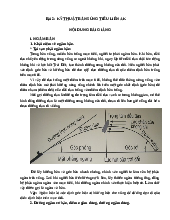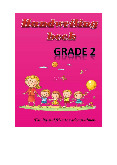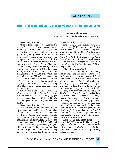



Preview text:
D°¡ng Đình Long PPHDH_1194_Nhóm 3
XÁC ĐỊNH PHONG CÁCH HỌC TẬP CÁ NHÂN
1. BIỂU ĐỒ KẾT QUẢ:
2. PHÂN TÍCH KẾT QUẢ TỪ 8 YẾU TỐ:
_ Em thích học thông qua việc thao tác với các đối t°ợng, làm thí nghiệm thực tế, và học hỏi
bằng cách làm thử. Em thích làm việc theo nhóm để tìm ra vấn đề.
_Em tìm hiểu thông qua những thông tin cụ thể, thiết thực và mang tính quy trình. Em muốn
đ°ợc biết về nguồn gốc và sự thật của vấn đề.
_Em sẽ có hứng thú học tập h¡n khi nhìn vào những hình ảnh, đồ thị hay s¡ đồ. Em sẽ nhìn
nhận một cách trực quan và bao quát của vấn đề.
_Em thích thông tin trình bày theo một chuỗi và theo trật tự. Em sẽ sắp xếp các chi tiết lại
với nhau để nhìn ra bức tranh tổng thể.
3. ƯU – NHƯỢC ĐIỂM CỦA BẢN THÂN: 3.1 ¯u điểm:
_Em sẽ tìm hiểu thông tin và ghi nhớ tốt nhất khi đ°ợc nhìn thấy vấn đề một cách trực tiếp.
Đồng thời kết nối vấn đề với thực tế và đ°a ra giải pháp.
_Em sẽ nhìn nhận vấn đề nhanh chóng khi đ°ợc xem xét thông qua s¡ đồ, hình ảnh, đồ thị,…
_Em có suy nghĩ thấu đáo về giải pháp mình đ°a ra, luôn thử nghiệm và thao tác với vấn đề
để tìm ra cách giải quyết tốt nhất. Đồng thời em sẽ có thể giao tiếp khi tham gia vào 1 nhóm
để giải quyết vấn đề.
_Em có thể nhìn nhận bức tranh tổng thể thông qua những mảnh ghép chi tiết. 3.2 Nh°ợc điểm:
_Em sẽ không thể tiếp thu tốt nếu 1 tiết học có phần lớn là lý thuyết trừu t°ợng. Em sẽ gặp
khó khăn khi ghi nhớ và áp dụng nó vào thực tế.
_Em sẽ phải hỏi lại giảng viên nhiều lần để hiểu đ°ợc 1 vấn đề và làm thế nào để khai thác
đ°ợc nhiều thông tin h¡n.
_Em sẽ gặp một chút khó khăn nếu phải giải quyết vấn đề nghiêm trọng nào đó một mình,
đồng thời không thể hiểu một bức tranh tổng thể nếu không có dữ kiện chi tiết.
4. BẢN GỐC TIẾNG ANH:
Active learners tend to retain and understand information best by doing something active
with it4discussing or applying it or explaining it to others. Reflective learners prefer to think about it quietly first.
is the reflective learner’s response.
Active learners tend to like group work more than reflective learners, who prefer working alone.
Sitting through lectures without getting to do anything physical but take notes is hard for both
learning types, but particularly hard for active learners. Everybody is active sometimes and
reflective sometimes. Your preference for one category or the other may be strong,
moderate, or mild. A balance of the two is desirable. If you always act before reflecting you
can jump into things prematurely and get into trouble, while if you spend too much time
reflecting you may never get anything done.
If you are an active learner in a class that allows little or no class time for discussion or
problem-solving activities, you should try to compensate for these lacks when you study.
Study in a group in which the members take turns explaining different topics to each other.
Work with others to guess what you will be asked on the next test and figure out how you will
answer. You will always retain information better if you find ways to do something with it.
Sensing learners tend to like learning facts, intuitive learners often prefer discovering
possibilities and relationships.
Sensors often like solving problems by well-established methods and dislike complications
and surprises; intuitors like innovation and dislike repetition. Sensors are more likely than
intuitors to resent being tested on material that has not been explicitly covered in class.
Sensors tend to be patient with details and good at memorizing facts and doing hands-on
(laboratory) work; intuitors may be better at grasping new concepts and are often more
comfortable than sensors with abstractions and mathematical formulations.
Sensors tend to be more practical and careful than intuitors; intuitors tend to work faster and
to be more innovative than sensors.
Sensors don’t like courses that have no apparent connection to the real world; intuitors don’t
like Everybody is sensing sometimes and intuitive sometimes. Your preference for one or the
other may be strong, moderate, or mild. To be effective as a learner and problem solver, you
need to be able to function both ways. If you overemphasize intuition, you may miss
important details or make careless mistakes in calculations or hands-on work; if you
overemphasize sensing, you may rely too much on memorization and familiar methods and
not concentrate enough on understanding and innovative thinking.
Sensors remember and understand information best if they can see how it connects to the
real world. If you are in a class where most of the material is abstract and theoretical, you
may have difficulty. Ask your instructor for specific examples of concepts and procedures,
and find out how the concepts apply in practice. If the teacher does not provide enough
specifics, try to find some in your course text or other references or by brainstorming with friends or classmates.
Visual learners remember best what they see4pictures, diagrams, flow charts, time lines,
films, and demonstrations. Verbal learners get more out of words4written and spoken
explanations. Everyone learns more when information is presented both visually and verbally.
In most college classes very little visual information is presented: students mainly listen to
lectures and read material written on chalkboards and in textbooks and handouts.
Unfortunately, most people are visual learners, which means that most students do not get
nearly as much as they would if more visual presentation were used in class. Good learners
are capable of processing information presented either visually or verbally.
If you are a visual learner, try to find diagrams, sketches, schematics, photographs, flow
charts, or any other visual representation of course material that is predominantly verbal.
Ask your instructor, consult reference books, and see if any videotapes or CD-ROM displays
of the course material are available. Prepare a concept map by listing key points, enclosing
them in boxes or circles, and drawing lines with arrows between concepts to show
connections. Colorcode your notes with a highlighter so that everything relating to one topic is the same color.
Sequential learners tend to gain understanding in linear steps, with each step following
logically from the previous one. Global learners tend to learn in large jumps, absorbing
material almost randomly without seeing connections, and then suddenly Sequential learners tend to follow logical stepwise paths in finding solutions; global learners
may be able to solve complex problems quickly or put things together in novel ways once
they have grasped the big picture, but they may have difficulty explaining how they did it.
Many people who read this description may conclude incorrectly that they are global, since
everyone has experienced bewilderment followed by a sudden flash of understanding. What
makes you global or not is what happens before the light bulb goes on. Sequential learners
may not fully understand the material but they can nevertheless do something with it (like
solve the homework problems or pass the test) since the pieces they have absorbed are
logically connected. Strongly global learners who lack good sequential thinking abilities, on
the other hand, may have serious difficulties until they have the big picture. Even after they
have it, they may be fuzzy about the details of the subject, while sequential learners may
know a lot about specific aspects of a subject but may have trouble relating them to different
aspects of the same subject or to different subjects.
Most college courses are taught in a sequential manner. However, if you are a sequential
learner and you have an instructor who jumps around from topic to topic or skips steps, you
may have difficulty following and remembering. Ask the instructor to fill in the skipped steps,
or fill them in yourself by consulting references. When you are studying, take the time to
outline the lecture material for yourself in logical order. In the long run doing so will save you
time. You might also try to strengthen your global thinking skills by relating each new topic
you study to things you already know. The more you can do so, the deeper your
understanding of the topic is likely to be.




